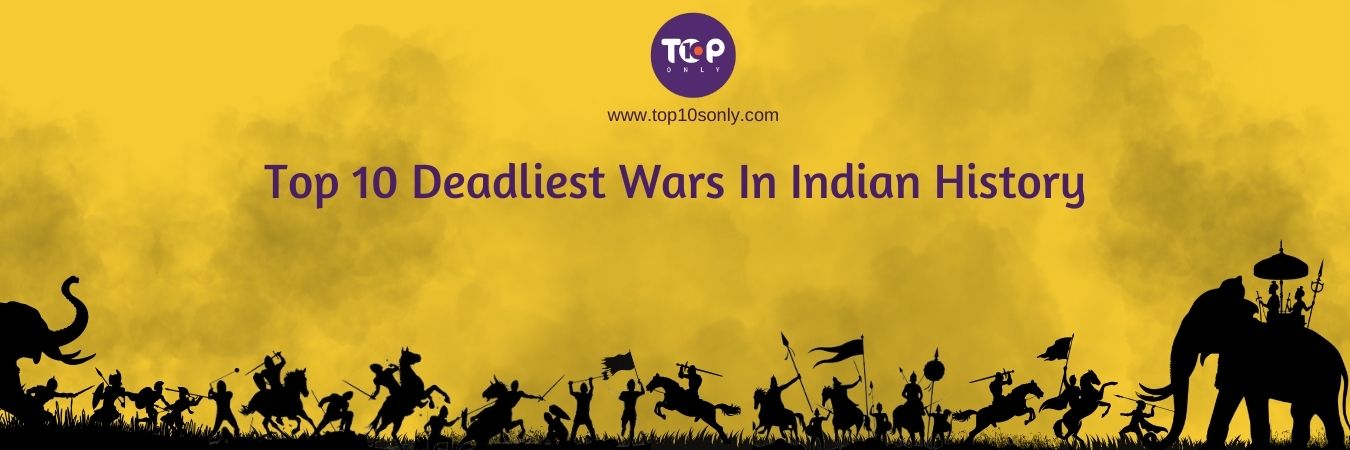
Wars have played a major role in creating and destroying empires and states throughout history. Even in the Indian subcontinent, several significant wars have been fought from ancient to modern times, and numerous far-reaching changes have happened due to these wars. These wars reshaped India and have had a profound impact on the country’s political, social, and cultural landscape. The Top 10s Only team has put together a list of the Top 10 Significant Wars In Indian History. So, let’s take a brief look at some of the major wars in Indian history that saw the downfall of dynasties and the rise of new eras.
List Of Top 10 Biggest Wars In The History Of India
India has seen fierce battles right from ancient times. The need for regional expansion and accumulation of wealth prompted some of the most famous historical wars India had ever seen. The wars in later centuries were primarily fought against foreign invaders. These wars have been a turning point in the history of the subcontinent and, as a result, changed the future forever. Here are the top 10 wars that changed history in India.
1. Nanda-Mauryan War (323 – 321 BCE)
The Nanda-Mauryan War was a conflict that arose in ancient India between the Nanda dynasty king Dhana Nanda and Maurya Empire king Chandragupta Maurya in Magadha. While not much is known from historical accounts, it is believed that Chandragupta Maurya used guerilla tactics to overwhelm the Nanda Empire, as they had a large army. In 322 BC, Chandragupta Maurya and his lieutenant Chanakya besieged the Nanda capital Pataliputra and ended the war. The estimated number of deaths of soldiers is said to be around 1 lakh, along with the death of 1 lakh horses and 10,000 elephants. This brought an end to the rule of the Nanda dynasty and established the Maurya empire with Chandragupta Maurya as the emperor. This empire eventually became the most expansive in India.
2. Kalinga War (261 BCE)
One of the most famous wars in Indian history, the Kalinga War was a conflict between the state of Kalinga and the Mauryan Empire under Ashoka the Great. This ancient Indian war is considered one of the deadliest wars in Indian history, and the immense death toll prompted King Ashoka to give up future conquests. Kalinga (present-day Odisha and parts of Andhra Pradesh) was a wealthy and prosperous state ruled by the Nanda Empire. The Mauryan Empire considered Kalinga a threat as it could potentially disrupt communication between Pataliputra (the capital of the Mauryan Empire) and their central Indian Peninsula holdings. Ashoka sent a message to the Kalinga King to surrender. When the Kalinga King did not heed Ashoka’s demands, one of the most bloodiest wars in Indian history broke out in 261 BCE, which resulted in the killing of approximately 2 lakh people and injuring many more. Though Ashoka was victorious, the deaths affected him so much that he vowed never to wage a conquest, thus initiating an era of peace, prosperity and harmony.
3. Mongol Invasion Of India (1306)
The Mongols were a powerful nomadic tribe that lived on the Central Asian plains, from the Ural mountains to the Gobi Desert. Genghis Khan, their warlord, started a conquest that resulted in the Mongols having the largest contiguous empire in history, extending from Korea in Asia to as far as Poland’s borders in Europe. The Mongol invasion of India in 1306 was an attempt to enter the Indian subcontinent. Alauddin Khilji, known for his military prowess, responded decisively and successfully repelled the invasion. The Mongols suffered heavy losses. Thousands were killed and the survivors were enslaved. The Mongol Invasion was one of the great wars in Indian history. Their defeat was a turning point, as it demoralised the invaders and also quashed their attempt to capture Indian territory. It also secured the Delhi Sultanate’s rule in India.
4. Bahmani-Vijayanagar War (1362 – 1367)
The Bahmani Vijayanagar War is the next one on our list of wars in Indian history. It was fought in the Deccan region between the Vijaynagar Empire and the Bahmani Sultanate. The conflict started due to disputes over the banning of Vijaynagar coins by Bahmani ruler Muhammed Shah I. This prompted Bukka Raya I of the Vijaynagar Empire to form alliances and retaliate. The most notable aspects of this war were the use of infantry and the involvement of European mercenaries. The war intensified when Bahamanis executed Warangal’s prince due to disputes over horse trading and captured Warangal. The Bahmani army captured many key places like Kauthal and Mudgal and caused heavy casualties. Bukka Raya sought peace after Vijayanagar was besieged and people were massacred by Muhammed Shah in 1367. A treaty was signed so that both would refrain from civilian killings in the future, but it was violated many times.
5. Deccan Wars (1680 – 1707)
The Deccan Wars are also called the ‘War of 27 Years’ and the ‘Mughul-Maratha Wars’, as it was a series of wars fought between the Mughal empire and the Marathas. The war started in 1680 when Maratha ruler Sambhaji supported the rebellious son of Mughal Emperor Aurangzeb, thus incurring his wrath. This was one of the most important wars in Indian history, as it saw the involvement of the British, Portuguese and other nations. The fierce battles resulted in more than half a million soldiers being lost in the battle. The Deccan Wars lasted 27 years until the death of Mughal Emperor Aurangzeb. It involved many battles and given their might, the Mughals appeared to win easily, but the Marathas won against all odds. After massive casualties, the Mughal Empire split into various kingdoms and the Marathas expanded to the North and took over the Mughal territories.
6. The Revolt Of 1857 (May 1857 – November 1858)
The Revolt of 1857 is definitely one of the most significant wars in Indian history before independence. The Indian Rebellion of 1857 is called by various names like the Sepoy Mutiny, the First War of Independence, etc. This Great Rebellion was a major uprising against the British East India Company, albeit unsuccessful. The revolt started in 1857 at Meerut as a sepoy mutiny against the British officials in the Bengal Presidency. Though various political, social and economic factors were contributing factors, the major cause for this uprising was the usage of the Enfield rifle. These soldiers had to bite the cartridge (made using cow fat or pig fat) before loading it into the gun. Muslim and Hindu soldiers were outraged by this, as pork and cow meat were forbidden for them. On May 10, 1857, the sepoys staged a mutiny at Meerut against the oppressive British officers. Lord Canning, the governor-general during that time, withdrew the cartridges, but the damage was done, and the revolt spread to various places. The revolt lasted a year and was suppressed by the end of 1858. The uprising was important as it ended the rule of the East India Company, and India came under the direct rule of the British. There were large-scale deaths as a result of this uprising, with about 8 lakh Indians killed, but it also planted the seeds of nationalism and the need for freedom.
7. Indo-Pakistani War of 1947 – 1948
The Indo-Pakistani War of 1947–48 is one of the most important wars in Indian history after independence. Also called the first Kashmir War, it was fought between the newly independent countries, India and Pakistan, over Jammu and Kashmir, a princely state at that time. The war was initiated by Pakistan, who launched a tribal militia to capture Kashmir and stop the Kashmir ruler from joining India. Maharaja Hari Singh, the ruler of Jammu and Kashmir, pleaded for assistance from India. India offered support after he signed the Instrument of Accession with India. Pakistan forces and militia were met with stiff resistance from Indian troops. By 1948, the fighting consolidated along the Line of Control, with the conflict ending on the 1st of January 1949 with a ceasefire. The war was deemed a stalemate, but India gained control of a majority of the disputed territory, which was a strategic victory for the country.
8. Sino-Indian War (1962)
The Sino-Indian War, also called the China-India War, was an armed conflict between India and China that happened between October and November 1962. Fighting occurred along the Indian border with China in the North-East Frontier Agency. The trigger for the conflict was India granting asylum to the exiled Tibetan leader, Dalai Lama. The Chinese military became more aggressive after failed diplomatic negotiations, and on 20th October 1962 Chinese troops launched an invasion, pushed Indian forces back and captured key places. The conflict ended when China declared a ceasefire on 20th November 1962, and withdrew to its pre-war position. The war, which was high-altitude mountain warfare, resulted in the deaths of about 1696 soldiers. The consequences of the Sino-Indian War of 1962 caused several changes in India’s defence policy.
9. Bangladesh Liberation War (1971)
The Bangladesh Liberation War, also called the Bangladesh War of Independence, was a conflict that helped Bangladesh gain independence from Pakistan. One of the worst wars in Indian history, it was initiated as there were political disputes, civil unrest against Pakistan and a rise in Bengali nationalism in East Pakistan (current Bangladesh). In response, on 25th March 1971, the Pakistan Army launched Operation Searchlight, where there was a genocide of Bengali civilians. Responding to it, a guerrilla resistance force, Mukti Bahini, resisted their efforts by sabotaging Pakistani forces and liberating towns. India had to join the war after Pakistan attacked Indian military bases. The combined forces of Mukti Bahini and the Indian military were too much for Pakistan and led to surrender on 16th December 1971. The war helped Bangladesh become an independent nation, but the violence left about 2 to 3 million dead and millions displaced.
10. Kargil War (May – July 1999)
The Kargil War was fought between India and Pakistan and happened along the Line of Control in Kashmir in Kargil, Ladakh. The war, known as Operation Vijay, was triggered when Pakistani soldiers infiltrated the Indian side of LOC disguised as Kashmiri militants. Initially, Pakistan claimed they were insurgents but later admitted the involvement of Pakistani forces. India responded to the infiltration with military attacks and reclaimed occupied positions. There was a heavy fight in high-altitude terrain, and India got back most of the territory after Pakistan lost and had to withdraw. The Kargil War added a new dimension as it involved two nuclear-armed states fighting against each other. As per Indian officials, about 700 to 1,200 Pakistani soldiers were killed, with over 1000 wounded.
Understand The History Of Indian Wars And Its Impact
India is a diverse and rich country with a history of thousands of years, as it is among the oldest civilisations in the world. It has a great historical and cultural legacy and has seen its fair share of conflicts and wars from ancient times to the modern era. The above are some of the most significant wars in Indian history that left an indelible mark on India’s political, cultural, and social landscape. Studying the causes and impacts of these wars not only provides invaluable information about India’s past but also provides a deep insight into the enduring spirit of a nation continually evolving towards peace and unity.
